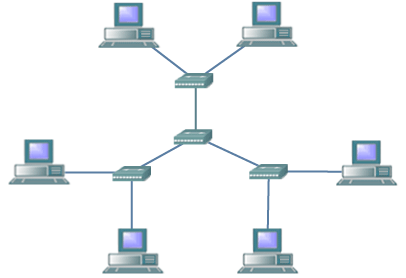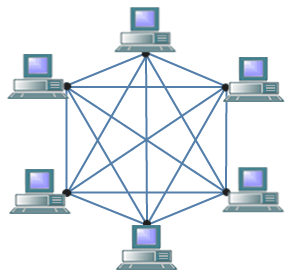|
|
|
 |
 |
 |
 |
 |
 |
|
|
|
|
|

 Internetworking Basics Internetworking Basics |
|

|
|
|
|
 |
 |
|
 |
| |
 Chapter 2: Networking Fundamentals Chapter 2: Networking Fundamentals
LAN Topologies
These notes guide you through the understanding of the networking fundamentals.
Introduction
Bus Topology
Star Topology
Ring Topology
Mesh Topology
Tree Topology
Physical vs Logical Topology
Summary
| |
| |
Introduction
Every LAN has a topology, which is the way devices are arranged and communicate with each other. The way workstations and other LAN devices are arranged and connect to each other is called physical topology. Whereas the way they communicate (send signals to each other) is called logical topology. Sometimes a LAN may have different physical and logical topologies.
Common LAN topologies are:-
- Bus
- Star
- Extended Star
- Ring
- Mesh
- Tree (hierarchical)
More complex networks can be built as hybrids out of the basic topologies listed above .
The following notes explain each topology in a little more detail. |
| |
Bus Topology
In a bus topology, all devices are connected to a central cable called a bus. A bus is also known as a backbone.

Each device connected the bus can send signals along the bus cable to other connected devices. A terminator is placed at each end of the cable to absorb any signal that reaches it. This is to stop signals bouncing back and causing errors.
Any device wanting to communicate with another device on the network sends a broadcast message onto the bus that all other devices see. Only the intended recipient actually accepts and processes the message. Unfortunately, data packets and broadcast messages being sent from many hosts along the same bus can often lead to data collisions on the bus .
Bus topologies used to be the most widely used LAN topology. This is no longer the case; star topologies are much more common today.
The bus medium is typically 10Base-2 (ThinNet) or 10Base-5 (ThickNet) coaxial cable. |
| |
Star Topology
In a star topology, all devices are connected to a central connection device, which may be a hub, switch or router. When one device wants to communicate with another device, any signals it sends passes through the central connection device first.

One of the advantages a star topology has over a bus topology is that each device is connected to the central connection device using its own cable. This means that if there is any problem with one cable connecting a host to the center, this does not affect any other hosts.
This is in contrast to a bus topology, where any problem with the central cable affects all connected devices and the network fails. The weakness of a star topology centers on the central connection device. If the central connection device fails then the network fails.
Devices are typically connected to the central connection device using Unshielded Twisted Pair (UTP) Ethernet cable.
Sometimes a star network grows into an extended star topology, as shown below.

|
| |
Ring Topology
In a ring topology, devices are connected to each other in a closed loop, which means each device is connected to two other devices, one on each side. In contrast to a bus topology, a ring topology has no beginning and no end.

Data is transmitted in an unusual way on a ring topology, using tokens.
A token travels continuously around the ring stopping at each node in turn. Any node that wishes to transmit data must attach that data to the token. The token is then passed along by each node (including any attached data) until it reaches its intended destination, where it delivers the data. The token then continues on its way.
Examples of networks that pass tokens are:-
- Token Ring
- Fiber Distributed Data Interface (FDDI)
- Arcnet
(Arcnet is different - it passes tokens on a bus topology)
One major advantage of token rings, is that there is no danger of data colliding since only one token, (with or without any attached data), ever travels around the ring.
Another advantages of ring networks is that they can span larger distances than other types of networks, such as bus networks, because each node regenerates the signal as the token passes through.
Finally, there are different types of token ring:-
- Single Ring
- Dual Ring
- Star Wired Ring
Single Ring:
In a single ring, there is one cable ring. The token circles around the ring in one direction only. If there is a problem with the ring then the network fails.
Dual Ring:
In a dual ring, there are two cable rings and data can be sent in a different direction on each ring. An advantage of a dual ring is - if there is a problem with one of the rings then data can be transmitted on the other ring. A disadvantage is - it is more expensive.
|
| |
Mesh Topology
In a full-mesh topology, every node is connected to every other node.

This type of topology has many advantages and disadvantages.
It's main advantage is its high fault tolerance, due to the many separate connections. If any one link fails between nodes then communication may still be possible through another route. This is why mesh topologies are commonly used between routers connecting WAN's (many segments of the Internet are connected in a mesh).
A major disadvantage is the expense and difficulty of cabling so many redundant connections.
In a partial-mesh topology, the majority of nodes may be connected together in some other arrangement, such as a star topology. However, you may have a few devices or even just one device that is fully meshed to all other nodes. |
| |
Tree Topology
A tree topology combines bus and star topologies. A tree topology is also known as a hierarchical topology.
In one type of tree, a backbone-tree, groups of star-configured networks are connected to a linear bus backbone.
This sort of arrangement has the advantage of allowing an existing network to expand easily.

A major disadvantage is if the backbone cable breaks, the entire network segment fails.
In another type of tree, a binary-tree, the first node splits into two links, then each of the two nodes on those links split into a further two links, and then each of the four nodes on those links split into a further to nodes... etc.

One consideration in setting up a tree topology is the 5-4-3 rule for Ethernet LAN's. Without going into the details of the rule here, in effect this means that there are only so many repeaters, network segments and backbone types allowed between any two nodes on the network . This is in order to comply with the Ethernet protocol which specifies that a signal sent by a node on the network must be able to reach any other node in a specific length of time. |
| |
Physical vs Logical Topology
One confusing thing to take on board about topologies is that there are two different aspects to consider:-
- Physical Topology
- Logical Topology
A physical topology is how devices on a network are arranged with respect to each other. In other words, the arrangement in which they are connected to each other physically with cables. We have seen examples of different physical topologies above.
A logical topology is to do with how devices on a network communicate and pass data across the medium from one device to the next - without regard to the physical interconnection of the devices.
On a logical bus network, the transmission media is shared. Devices pass data across the medium either by sending the data directly to another device using a NIC address, or by sending broadcast or multicast messages.
On a logical ring network, devices use token passing when sending data to each other.
A network's logical topology is not necessarily the same as its physical topology.
Example 1: Consider a network that is physically arranged as a star.
The devices pass data across the medium either by sending the data directly to another device using a NIC address, or by sending broadcast or multicast messages.This is the same way a bus topology works.
So, this network may have the physical layout of a star, but logically it acts as a bus.
Example 2 : Now consider a ring topology.
A ring is logically nothing like a bus because the method of communication between devices is completely different. Devices on a ring topology pass data using tokens as mentioned earlier. However, a ring topology may be physically arranged in a star layout, with cables all connected to a central connection device. The token still gets passed around in a circular fashion.
So, this network may have the physical layout of a star, but logically it acts as a ring.
The diagram below shows a star-wired ring.

Token-Ring networks have star-wired ring topologies. Individual devices are connected to a central hub, as they are in a star. However, within each hub the physical connections form a ring. The hubs are intelligent in that if the physical ring is somehow broken, each hub is able to close the circuit at any point in its internal ring so that the ring is restored. FDDI networks are usually set up as both physical and logical rings.
The table below gives an overview of common physical/logical network combinations.
| Protocol |
Physical Topology |
Logical Topology |
Ethernet Bus - 802.3
10Base2 or 10Base5 |
Bus |
Bus |
Ethernet Star - 802.3
10Base-T or 10Base-Tx
|
Star |
Bus |
| Token Ring - 802.5 |
Star-wired Ring |
Ring |
FDDI |
Ring |
Ring |
|
|
| |
Summary
The four basic topologies--switched, star, ring, and bus--can be implemented simply, or in combination with each other to create more hybrid networks. The most common approach today is to use a physical layout arranged as a star-wired bus, although Token Ring and FDDI are also used.
|
 |
|
 |
|
 |
|
 |
|
| |
|
|

|






 Internetworking Basics
Internetworking Basics ![]()
